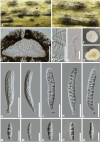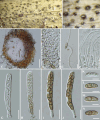Morpho-phylogenetic evidence reveals novel Bambusicolous fungi from Guizhou Province, China
- PMID: 40496200
- PMCID: PMC12149888
- DOI: 10.3897/mycokeys.118.149455
Morpho-phylogenetic evidence reveals novel Bambusicolous fungi from Guizhou Province, China
Abstract
The diversity and ecological importance of fungi associated with bamboo ecosystems are increasingly recognized, as these fungi play crucial roles in nutrient cycling and bamboo decomposition. This study identified five ascomycetous species from decaying bamboo stems in Guizhou, China. Phylogenetic analyses based on a concatenated dataset of SSU, ITS, LSU, rpb2, and tef1-α sequences confirmed their placement within the family Bambusicolaceae. Three new species, Bambusicolapseudodimorphae, Bambusicolagelatinosospora, and Bambusicolaellipsospora, are described as new to science, while two previously known species, Bambusicolaautumnalis and Corylicolaitalica, are also reported. Notably, this study provides the first account of the asexual morph of Bambusicolaautumnalis, and Corylicolaitalica is newly recorded from China. Comprehensive morphological descriptions, illustrations, and phylogenetic assessments are presented, contributing to the expanding knowledge of fungi. These findings underscore the importance of continued exploration of fungal diversity in bamboo ecosystems.
Keywords: 3 new taxa; Bambusicolaceae; multi-gene; phylogeny; taxonomy.
Yao Feng, Ya-Ya Chen, Chuan-Gen Lin, Zuo-Yi Liu, Xiao-Fang Chen, Guo-Shun Pei, Jian-Kui Liu.
Conflict of interest statement
The authors have declared that no competing interests exist.
Figures








References
-
- Boonmee S, Wanasinghe DN, Calabon MS, Huanraluek N, Chandrasiri SKU, Jones GEB, Rossi W, Leonardi M, Singh SK, Rana S, Singh PN, Maurya DK, Lagashetti AC, Choudhary D, Dai YC, Zhao CL, Mu YH, Yuan HS, He SH, Phookamsak R, Jiang HB, Martín MP, Dueñas M, Telleria MT, Kałucka IL, Jagodziński AM, Liimatainen K, Pereira DS, Phillips AJL, Suwannarach N, Kumla J, Khuna S, Lumyong S, Potter TB, Shivas RG, Sparks AH, Vagheff N, Abdel-Wahab MA, Abdel-Aziz FA, Li GJ, Lin WF, Singh U, Bhatt RP, Lee HB, Nguyen TTT, Kirk PM, Dutta AK, Acharya K, Sarma VV, Niranjan M, Rajeshkumar KC, Ashtekar N, Lad S, Wijayawardene NN, Bhat DJ, Xu RJ, Wijesinghe SN, Shen HW, Luo ZL, Zhang JY, Sysouphanthong P, Thongklang N, Bao DF, Aluthmuhandiram JVS, Abdollahzadeh J, Javadi A, Dovana F, Usman M, Khalid AN, Dissanayake AJ, Telagathoti A, Probst M, Peintner U, Garrido-Benavent I, Bóna L, Merényi Z, Boros L, Zoltán B, Stielow JB, Jiang N, Tian CM, Shams E, Dehghanizadeh F, Pordel A, Javan-Nikkhah M, Denchev TT, Denchev CM, Kemler M, Begerow D, Deng CY, Harrower E, Bozorov T, Kholmuradova T, Gafforov Y, Abdurazakov A, Xu JC, Mortimer PE, Ren GC, Jeewon R, Maharachchikumbura SSN, Phukhamsakda C, Mapook A, Hyde KD. (2021) Fungal diversity notes 1387–1511: Taxonomic and phylogenetic contributions on genera and species of fungal taxa. Fungal Diversity 111(1): 1–335. 10.1007/s13225-021-00489-3 - DOI - PMC - PubMed
-
- Brahmanage RS, Dayarathne MC, Wanasinghe DN, Thambugala KM, Jeewon R, Chethana KWT, Samarakoon MC, Tennakoon DS, De Silva NI, Camporesi E, Raza M, Yan JY, Hyde KD. (2020) Taxonomic novelties of saprobic Pleosporales from selected dicotyledons and grasses. Mycosphere 11: 2481–2541. 10.5943/mycosphere/11/1/15 - DOI
-
- Chomnunti P, Hongsanan S, Aguirre-Hudson B, Tian Q, Peršohm D, Dhami MK, Alias AS, Xu JC, Liu XZ, Stadler M, Hyde KD. (2014) The sooty moulds. Fungal Diversity 66(1): 1–36. 10.1007/s13225-014-0278-5 - DOI
-
- Crous PW, Wingfield MJ, Schumacher RK, Summerell BA, Giraldo A, Gené J, Guarro J, Wanasinghe DN, Hyde KD, Camporesi E, Jones EBG, Thambugala KM, Malysheva EF, Malysheva VF, Acharya K, Álvarez J, Alvarado P, Assefa A, Barnes CW, Bartlett JS, Blanchette RA, Burgess TI, Carlavilla JR, Coetzee MPA, Damm U, Decock CA, den Breeÿen A, de Vries B, Dutta AK, Holdom DG, Rooney-Latham S, Manjón JL, Marincowitz S, Mirabolfathy M, Moreno G, Nakashima C, Papizadeh M, Shahzadeh Fazeli SA, Amoozegar MA, Romberg MK, Shivas RG, Stalpers JA, Stielow B, Stukely MJC, Swart WJ, Tan YP, van der Bank M, Wood AR, Zhang Y, Groenewald JZ. (2014) Fungal Planet description sheets: 281–319. Persoonia 33: 212–289. 10.3767/003158514X685680 - DOI - PMC - PubMed
-
- Dai DQ, Bhat DJ, Liu JK, Chukeatirote E, Zhao RL, Hyde KD. (2012) Bambusicola, a new genus from bamboo with asexual and sexual morphs. Cryptogamie. Mycologie 33(3): 363–379. 10.7872/crym.v33.iss3.2012.363 - DOI
LinkOut - more resources
Full Text Sources
